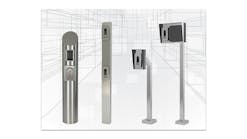Upgrading an opening to electronic access control (EAC) is a good revenue provider for security pros. In June 2022, we provided an overview on how to approach door openings for conversion to EAC (“Bringing Electronics to the Door”). The discussion focused on retrofitting or upgrading a door opening for EAC without regard to whether it must integrate with a computer-operated access control system or network. This article will discuss such integration.
Some of you might be adept at integrating a door opening with a larger enterprise access control network. This article, however, is aimed at those who might have the opportunity to provide retrofits for access control but are uncomfortable when it comes to hooking up to the network.
Making the Connection
You’re the door expert, not the IT and software expert. You might be reticent to take on jobs that potentially can open a bag of snakes that include callbacks for software and hardware conflicts, incorrect settings or even general liability for IT issues that might not be the result of your installation.
The good news is help is available. It always is recommended that you invest in yourself and your business through education and training, no matter the subject. To become more proficient in the best practices for integrating door openings into an access control network, consider online training courses from the Electronic Security Association at esaweb.org, SecurityCEU.com or even online modules offered by many of the industry’s manufacturers.
PoE solutions can be as simple as tapping into the nearest Ethernet connection to power and control door access through a web browser and low-voltage access and egress devices. In fact, if you become comfortable at recommending and installing PoE solutions, you can carve out a niche that serves smaller companies or single facilities that don’t require a full-blown enterprise system yet still want the convenience and 24/7 access of a computer-based EAC system.
Most of the industry’s manufacturers offer low-voltage PoE hardware and components for EAC, including maglocks, key and exit switches, electrified exit devices, electrified locksets, electric bolt locks, automatic door operators and even cabinet locks to attach to a network system through Ethernet cable.
Several manufacturers also offer IP-based door controllers that are powered by Ethernet cables, connect to the existing network structure and require no software to install. You simply plug the controller into a wired LAN connection and use the web browser on a computer or a smartphone to set up and manage the system. These PoE/IP-based controller solutions allow you to get in and out of a job quickly. Time is money, and it can be time-consuming to consult with an IT manager and find a suitable existing computer at a customer site.
Physical EAC solutions that use low-voltage PoE hardware, components and IP-based door controllers are suited particularly to tenant improvement and retrofit projects, because they provide the ability to purchase and install just what’s necessary. The beauty of a smaller system is that, in addition to a lower price, they also typically are easy to expand up to as many as 100 doors, depending on the manufacturer, as demands change.
Multidoor applications also are supported by several manufacturers. Some simply offer IP-based door controllers in two-, four-, six- or eight-door configurations that support brand-specific access and egress control hardware. Others provide the door controller and optional expansion boards for additional door openings that are nonbrand specific to the access or egress control hardware. Most offer free, preinstalled software that provides the functionality of a full computer-based EAC system and is managed via a web browser from a desktop, tablet or smartphone.
Check It Out
Depending on the type of installation and whether it’s a single door or multiple doors, you’ll have to survey where the Ethernet cable is or where electricity is available to power the system. If you use existing Ethernet cable, you might have to install a PoE splitter to provide power to your components. If, during your power survey, you realize that additional power is required from a power supply, you also might have to install a PoE injector to deliver the additional power to the system.
A word of caution: Don’t forget that any PoE access and egress solution that uses IP-based door controllers still has to meet all existing fire and life-safety codes. This includes using UL 294-approved hardware where required.
That said, if you can use legacy Ethernet cable with PoE hardware and an IP-based controller, it will save time, money and labor. As a result, you might be able to bring safe, secure, easy-to-implement EAC to what’s known as the network’s edge, without the headaches of costlier, more complicated enterprise solutions. As always, consult your local authority having jurisdiction (AHJ) for compliance requirements before you start any door installation project.
You can upgrade the door without being an IT expert and bridge the gap between traditional locking hardware and IT networks.
Kerby Lecka is marketing director at SDC – Security Door Controls, a manufacturer of premium-grade access control hardware. He can be reached at [email protected].
Kerby Lecka | Director of Marketing, SDC
Kerby Lecka is marketing director at SDC – Security Door Controls. He can be reached at [email protected].








